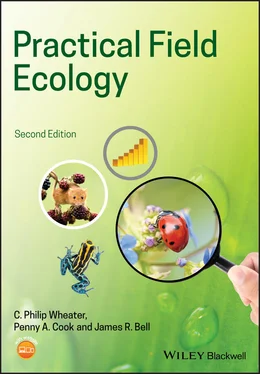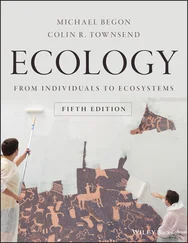Anemometers. (a) Cup anemometer – the device is held in the wind ... Figure 2.7
Environmental multimeter. Figure 2.8
Penetrometer. Comprises a gauge and a small cone connected to a r... Figure 2.9
Soil augers. (a) Soil gouge auger, core‐removing tool, and mallet... Figure 2.10
Bulb planters. Gardeners' bulb planters can be used to take core... Figure 2.11
Aquatic multimeters. These can be used to measure the physico‐ch...Figure 2.12
Secchi disk. This is a circular disk of 0.2–0.3 m diameter, colo...Figure 2.13
Dynamometer to measure wave action. As waves drag the ball, the ...Figure 2.14
Light meters. (a) Light, or lux, meters such this can give an in...Figure 2.15
Using ranging poles to measure the inclination of a slope. Rangi...Figure 2.16
Using a cross‐staff to survey a shoreline.Figure 2.17
Using a GPS. GPS can be used to estimate location and/or altitud...Figure 2.18
Lichen zone scale for mean winter sulphur dioxide estimation on...
3 Chapter 3Figure 3.1 Quadrats. From left to right – subdivided wire quadrat (with pin‐...Figure 3.2 Recording positions on a subdivided quadrat. Nine cords are set a...Figure 3.3 JNCC guideline usage of SACFOR scales. (a) Scales used for organis...Figure 3.4 Two nested quadrat designs. In (a) the area sampled and the total...Figure 3.5 Using random numbers to identify a position in a sampling grid. E...Figure 3.6 Comparison of the perimeter to area ratios of circular, square, a...Figure 3.7 Pin‐frame. From left to right: used on its own, used with a...Figure 3.8 Comparison of transect sampling techniques.Figure 3.9 Kite diagram to indicate the abundance of different species along...Figure 3.10 Using a clinometer. The angle from the horizontal to the top of...Figure 3.11 Tree coring. Atlas Cedar ( Cedrus atlantica ), being cored in Mor...Figure 3.12 Estimating canopy cover. Using a 10 × 10 grid on top of picture...
4 Chapter 4Figure 4.1 Observation and marking chambers for invertebrates. Invertebrates...Figure 4.2 Use of ink or paint spots to identify individual invertebrates. U...Figure 4.3 Differences in rhino horn shape and size that can be used to iden...Figure 4.4 Survivorship curves. Where: l xis the number surviving to a parti...Figure 4.5 ‘W’ shaped transect walk. Similar designs using ‘M’ s...Figure 4.6 Parabolic reflector concentrating sound onto the central micropho...Figure 4.7 Pond nets suitable for catching surface, pelagic, and bottom acti...Figure 4.8 Belleville mosquito larvae sampler. The cylinder (without the fun...Figure 4.9 Using a kick net and sorting the sample.Figure 4.10 Kick screen or banner net. Ensure that the bottom net is as clos...Figure 4.11 Surber sampler.Figure 4.12 Hess sampler.Figure 4.13 Drift net. Weights (dark spheres shown in the diagram on the lef...Figure 4.14 Plankton net. When the net is towed (a) or suspended (b) in the ...Figure 4.15 Suction sampler for animals in burrows.Figure 4.16 Naturalist's dredge. The mouth of this net is made of metal ...Figure 4.17 Grabs for collecting benthic animals. (a) Ekman grab with a remo...Figure 4.18 The Baermann funnel. A small sample is wrapped in muslin and pla...Figure 4.19 Bidlingmayer sand extractor. The sample is spread over the base ...Figure 4.20 Colonisation samplers. (a) Hester–Dendy multi‐plate samplers are...Figure 4.21 Crayfish traps. The funnel entrances allow the animals to enter ...Figure 4.22 Crayfish refuge trap. The steel base frame can be pegged into th...Figure 4.23 Soil sieves. (a) Gardener's soil sieve for separating coarse fra...Figure 4.24 Tullgren funnels. The soil core or leaf litter should be dried s...Figure 4.25 Kempson bowl extractor. The sample is placed between two grids, ...Figure 4.26 Winkler sampler. Samples may be dry‐sieved first using a fairly ...Figure 4.27 Simple inclined tray light separator. As the sample dries out, a...Figure 4.28 Baited pitfall trap.Figure 4.29 Setting pitfall traps.Figure 4.30 Barriers used with pitfall trap s. (a) Two or more traps can be ...Figure 4.31 Birds ‐eye view of an H‐trap. Barriers are made in t...Figure 4.32 Ramp trap. More sophisticated versions can have a ramp on each s...Figure 4.33 Suction sampler s. (a) and (b) G‐vac based on a modified garden ...Figure 4.34 Emergence traps. (a) Emergence traps that do not have a floor ca...Figure 4.35 Pooter used to suck up small invertebrates. (a) Pooter (aspirato...Figure 4.36 Sweep net and sweep netting invertebrates from a bush. Sweeping ...Figure 4.37 Beating tray s. (a) Black and white versions and (b) in use beat...Figure 4.38 Fogging in rainforest. The fogging illustrated was undertaken in...Figure 4.39 Nets for catching airborne insects. (a) Types of nets: (from lef...Figure 4.40 Rothamsted suction traps. From left to right: Rothamsted pop‐up ...Figure 4.41 Positioning of sticky traps.Figure 4.42 Bottle trap for flies and other flying insects. These can be mad...Figure 4.43 Attractant‐based traps. (a) Funnel trap; (b) Delta trap. (...Figure 4.44 Assembly trap. Virgin females are placed within the mesh contain...Figure 4.45 Trap‐nests for bees and wasps.Figure 4.46 Window trap. Animals hit the window – made of Perspex or netting...Figure 4.47 Malaise trap. Flies, wasps, and other insects hit the centre par...Figure 4.48 Slam trap. (a) Flying insects hit one of the four netting vanes ...Figure 4.49 Simple light trap s for insects. (a) Moths accumulating around a...Figure 4.50 Moth collection tent. Moths attracted to the light hanging in th...Figure 4.51 Examples of moth trap s. (a) Rothamsted trap with mains‐run 200‐...Figure 4.52 Different types of light used for moth trap s. From left to righ...Figure 4.53 Rotary trap.Figure 4.54 Water traps. (a) Coloured water (pan) traps. (b) Trap with lid a...Figure 4.55 Slurp gun. The nozzle can be added or removed depending on the s...Figure 4.56 Using snorkel and scuba gear to observe fish.Note: snorkelling ...Figure 4.57 Sport fishing techniques. (a) Spear gun; (b) coastal fishing usi...Figure 4.58 Examples of nets and traps. (a) Casting a net into shallow coast...Figure 4.59 Bottle trap for newts. Cut a plastic bottle in half and insert t...Figure 4.60 Drift fence with side‐flap bucket trap. Animals move along...Figure 4.61 Funnel traps for amphibians. The funnel entrances help to retain...Figure 4.62 Examples of layouts for drift fencing. (a) Ring fencing a pond: ...Figure 4.63 Artificial cover trap for amphibians. The trap is set in a suita...Figure 4.64 Concrete housing for a camera trap. This design was used in a ju...Figure 4.65 Equipment for catching reptiles at a distance. (a) Grabber; (b) ...Figure 4.66 Refuges as traps for reptiles. (a) Refuge trap – from left to ri...Figure 4.67 Measuring captured birds. (a) Tarsus length; (b) mass.Figure 4.68 Permanent bird hide.Figure 4.69 Bird observation tower. (a) Observation tower; (b) view over the...Figure 4.70 Transect layout for Breeding Bird Survey. Birds are counted from...Figure 4.71 Goose droppings surveyed using a quadrat. To survey bird droppin...Figure 4.72 Mist net ting. (a) mist nets set; (b) greenfinch caught in net; ...Figure 4.73 Propelled nets. (a) Clap net set. (b) Clap net launched. The net...Figure 4.74 Marking birds. (a) Using a standard metal ring; (b) using colour...Figure 4.75 Use of colour rings. Here, 15 individual birds have been marked ...Figure 4.76 Deer becoming aware of the observer's presence.Figure 4.77 Images caught using camera trap s in tropical forest. (a) Tapir;...Figure 4.78 Small mammal tracking tunnel.Figure 4.79 Mammal dung used as an indicator of species presence. (a) Hyena ...Figure 4.80 Sampling mammal hair. (a) Badger hair and (b) sheep wool caught ...Figure 4.81 Bat detector s. (a) Range of detectors – two heterodyne detector...Figure 4.82 Triangle bat walks with frequency settings appropriate for UK ba...Figure 4.83 Small mammal traps. (a) Aluminium Longworth trap; (b) plastic Tr...Figure 4.84 Longworth trap for small to medium sized mammals.Figure 4.85 Poison bait dispenser. Used more in conservation work to remove ...Figure 4.86 Mole traps. (a) Classic scissor trap. (b) Talpex type trap (prof...Figure 4.87 Harp trap.Figure 4.88 Cage trap. (a) and (b) medium sized cage trap; (c) cage traps su...Figure 4.89 Badger trap. (a) Trap from front; (b) trap set in undergrowth.
Читать дальше












